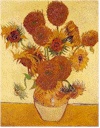|
The outlines of the images would have first been drawn as
an outline with pieces of charred wood or flint. Then, by blending dry pigments
from the land with plant juices, animal blood or fat, prehistoric man would
color in his drawings to create paintings.
As time went on, people used painting both as a form of decoration and as a way
to pay tribute to unforeseen forces.
Egyptian artists for example were commissioned to create paintings for temples
and mastabas as well as to decorate manuscripts. Paper was made from papyrus
reeds, "new" colors like green and blue were prepared from copper, and
gold leaf became popular. Later, the Greeks painted their temples much the way
we paint our homes today. The Romans copied the Greeks and went just a little
further. In fact, objects that we would think of as paint boxes have been found
by archaeologists. These kits contained up to eighty glass vessels (to hold
pigments), a mortar for grinding and an oblong object much like a paint palette.
Still later, early monks prepared pigments in order to decorate illuminated
manuscripts. By this time, vellum and parchment papers were used as were brushes
made of hog and sable hair. The monks worked with tempera paint, which was
essentially a mixture of powdered pigment and egg yolks or glue. As the
Renaissance approached, a technique involving dry pigment on wet plaster
(fresco) was also employed.
As time went on, monks began to mix pigments with oils and varnishes - and
voila, oil paint was invented. Old Masters spent a great deal of time sharing
their knowledge of paint with their apprentices who would grind pigment and
prepare canvas (beginning in the 15th century). It was all very time consuming.
Jean Van Eyck is credited with mastering the art of oil painting and his skill
can be seen in works like Portrait of Giovanni Arnolfini and his Wife.
By the time of the Impressionists, new colors were being produced. Colors like
cadmium yellow, ultramarine, cobalt blue, and alizarin crimson were very
different from the brown and yellow tones of the Old Master paintings.
Terminology
Pigment: Nearly all paint colors come from nature. Dirt, rock, plants, etc.
are the raw material, which is ground down into what is called a pigment. This
is then mixed with a binder to make it sticky (gum arabic - from trees, glue or
egg yolk), and a medium to make it liquid (water, oil).
Acrylic Paint: A thick shiny paint made by mixing pigment with water and an
acrylic base. Dries within a few hours.
Gouache (Poster Paint): A solid (opaque) water-based paint that dries to a
matt finish.
Fresco: The word is Italian for "fresh". The technique involves
painting with dry pigment on wet plaster. Fresco a secco involves painting on
dry plaster.
Oil Paint: A thick, shiny paint made by mixing pigment with oil (usually
linseed). Takes several days to dry.
Tempera: A water-based paint that may or may not be mixed with egg yolks
(egg tempera). Historically, tempera was used for Italian panel painting prior
to the late 16th century. Today, we associate tempera paint with elementary
school classrooms.
Watercolor: A soft and see-through (transparent) paint made from pigment,
water and gum arabic.
|
| Features On Site |
About Photography
About Pottery
About Watercolour
About Literature
About Jewelery
|
|
| Art Museums |
Art Gallery of Ontario
National Gallery
Musée d'art Contemporain
Beaux-Arts de Montréal
Guggenheim NY
Museum of Contemporary Canadian Art
Modern Art Museum
Musee du Louvre: France
Rijksmuseum: Holland
Smithsonian American Art
|
|
| Featured Artist |

Horse (cave painting)
c. 15,000-10,000 BC
Lascaux, France |
|
| Featured Artist |

Mona Lisa
Leonardo da Vinci
Oil on wood, 1503-1506
Musee du Louvre, France |
|
| Featured Artist |

Fourteen Sunflowers
in a Vase
Vincent van Gogh
Oil on canvas, 1888
National Gallery, London |
|
| Featured Artist |

Houses at L'Estaque Georges Braque
Oil on canvas, 1908
Kunstmuseum, Bern |
|
| Featured Artist |

Frieze (detail)
Jackson Pollock
Oil, enamel and aluminum paint on canvas, 1953-55
Private Collection. |
|
|

 John
Abrams
John
Abrams
 Annette Sheppard
Annette Sheppard
 Artist Number 3
Artist Number 3
 Artist Number 4
Artist Number 4
 Artist Number 5
Artist Number 5
 Artist Number 6
Artist Number 6
 Artist Number 7
Artist Number 7
 Artist Number 8
Artist Number 8
 Artist Number 9
Artist Number 9
 Artist Number10
Artist Number10




